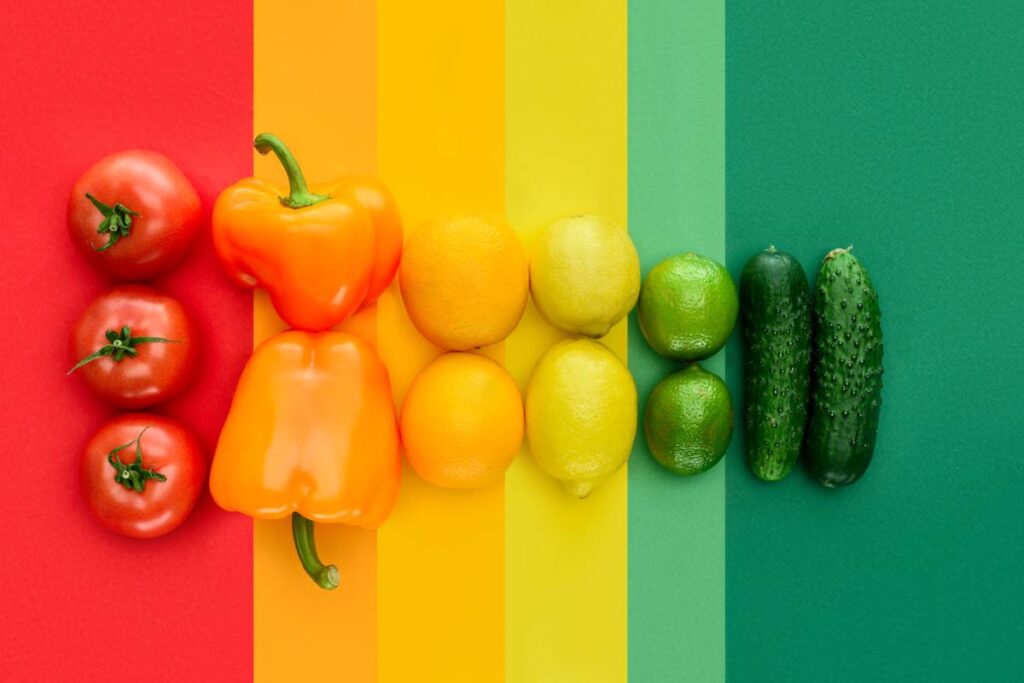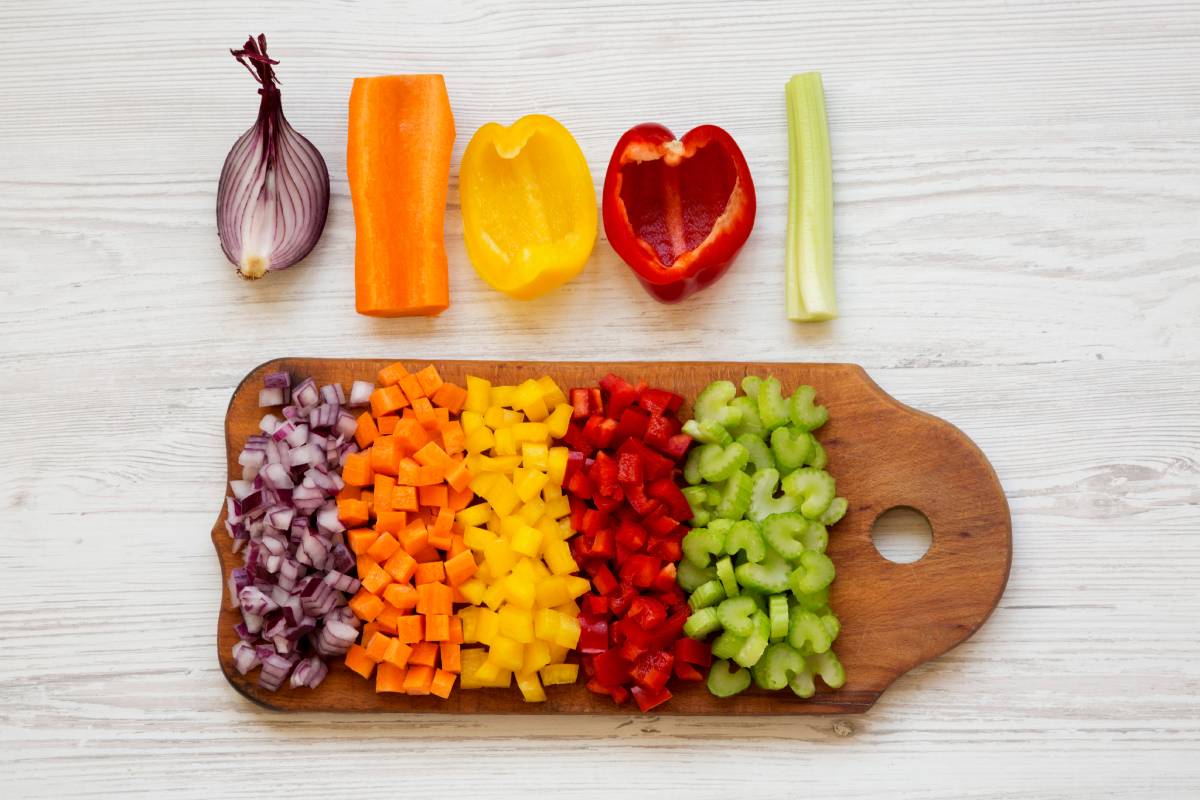
In a world where the focus on nutrition often revolves around counting calories or avoiding certain food groups, there’s a simpler and more vibrant approach to healthy eating: eating the rainbow. You’ve probably heard the phrase, but what does it really mean?
Essentially, it’s about incorporating a variety of colourful foods into your diet and for good reason. The colours in fruits and vegetables are not just eye-catching; they signal the presence of a range of essential nutrients and health-promoting compounds.
From antioxidant-rich reds to brain-boosting blues, each colour represents a unique set of benefits that contribute to a healthier body and mind.
In this article, we’ll explore why eating colourful food is so beneficial for your health, what different colours signify in terms of nutrition, and how you can easily incorporate more colourful foods into your diet for optimal well-being.
The Significance of Colour in Food

Color is more than just a visual appeal it’s a signal of the different compounds in food that offer a wide array of health benefits. These colours come from phytochemicals, plant-based compounds that provide health-promoting properties. From red tomatoes to green spinach and purple eggplant, each hue corresponds to specific nutrients that contribute to your well-being.
While we may often think of healthy foods as just green vegetables, healthy eating requires a more diverse palette of colours. From the reds of strawberries to the orange of carrots and the yellows of corn, eating a variety of colours ensures that you’re getting a broader spectrum of essential nutrients.
What Colors Represent Healthy Eating?
To understand how colour contributes to your health, it’s important to know what each colour typically represents in terms of nutrients:
Red
Red fruits and vegetables are rich in antioxidants like lycopene and anthocyanins. These nutrients are known for their anti-inflammatory and heart-healthy properties. Common red foods include tomatoes, red peppers, strawberries, and watermelon. Lycopene, in particular, has been linked to a reduced risk of prostate cancer and may also support heart health.
Orange and Yellow
Foods like oranges, carrots, sweet potatoes, and bell peppers are full of beta-carotene, which the body converts into vitamin A. Vitamin A is vital for maintaining good vision, immune function, and healthy skin. These foods also support the body’s ability to fight off infection and can improve skin texture and tone.

Green
Green foods are abundant in chlorophyll, vitamins, and minerals. Vegetables like spinach, kale, broccoli, and green beans are rich in folate, vitamin K, and magnesium, all of which are essential for maintaining healthy bones, reducing the risk of chronic diseases, and supporting optimal cellular function. Additionally, dark leafy greens are rich in antioxidants like lutein, which promotes eye health.
Blue and Purple
Blue and purple foods, such as blueberries, eggplant, and purple cabbage, are packed with anthocyanins. These compounds have powerful antioxidant properties that help fight oxidative stress and inflammation. Blue and purple foods can support heart health, improve memory, and may even have anti-aging effects.
White and Brown
White foods, including garlic, onions, cauliflower, and mushrooms, contain compounds like allicin and flavonoids that are known for their ability to boost the immune system and improve heart health. While they may not be as colourful as other foods, they still provide substantial nutritional benefits.
What Are the Benefits of Eating Colour?
Eating a variety of colourful foods is not just about making your plate look more attractive; it’s about consuming a variety of essential nutrients and plant compounds that your body needs. Here’s how these vibrant foods benefit your health:
Antioxidant-Rich Protection Against Disease:
Many fruits and vegetables are packed with antioxidants, which protect your body’s cells from damage caused by free radicals. This oxidative stress is a contributing factor in the development of chronic diseases, including heart disease, diabetes, and cancer. Eating a range of colourful foods ensures that you’re getting antioxidants in a variety of forms that work in synergy to reduce inflammation and protect your cells.

Boosted Immune Function:
A diverse intake of colourful fruits and vegetables strengthens the immune system. Vitamin C-rich fruits like oranges, strawberries, and kiwi contribute to immune function and can help fight off infections. Likewise, beta-carotene found in orange and yellow foods helps maintain healthy skin, the body’s first line of defense.
Better Digestive Health:
Colorful foods are typically high in fiber, which supports healthy digestion. Green vegetables like spinach, broccoli, and kale provide soluble and insoluble fiber, both of which promote a healthy gut. Fiber also aids in regulating blood sugar levels, which is essential for preventing or managing type 2 diabetes.
Improved Cardiovascular Health:
Heart disease remains one of the leading causes of death worldwide. However, eating a variety of colourful foods can help reduce the risk of developing cardiovascular diseases. Red and purple foods are rich in anthocyanins, which are shown to reduce the risk of heart disease by lowering blood pressure and improving cholesterol levels.
Enhanced Mental Health:
Emerging research suggests that the foods you eat may have a direct impact on your mental well-being. Colourful fruits and vegetables contain folate, vitamin C, and antioxidants, all of which have been shown to support brain health. In particular, the polyphenols in berries and other blue and purple foods have been linked to improved memory, mood, and cognitive function.
Eye Health:
Carotenoids like lutein and zeaxanthin, found in green, yellow, and orange vegetables, are critical for eye health. These nutrients can reduce the risk of age-related macular degeneration (AMD) and protect the eyes from harmful blue light exposure. Regular consumption of these colourful foods can help maintain good vision as you age.

Weight Management:
Colourful fruits and vegetables are naturally low in calories but high in nutrients and fiber. This combination helps you feel full longer and provides a greater sense of satiety, making it easier to manage your weight especially when aiming to stay within a healthy range based on your Body Mass Index (BMI). They also help regulate metabolism and blood sugar levels, which are essential for weight control.
The Science Behind the Colors
Each color in food signals a unique blend of nutrients and phytochemicals that support different aspects of health. Here are a few examples of how specific colors work to benefit your health:
- Red: Rich in lycopene and anthocyanins, red foods support heart health, reduce inflammation, and may protect against certain types of cancer.
- Orange and Yellow: Beta-carotene, found in these foods, is crucial for immune function and skin health. Vitamin C, present in orange foods like citrus fruits, also contributes to collagen production, which is important for skin elasticity.
- Green: Chlorophyll, which gives green vegetables their vibrant color, helps detoxify the body and supports the liver’s ability to eliminate toxins. These foods are also rich in magnesium, which supports muscle function and bone health.
- Blue and Purple: Anthocyanins are antioxidants that fight oxidative stress and inflammation. These compounds are also linked to cognitive function and brain health, particularly in preventing age-related memory loss.
- White and Brown: These foods provide immune-boosting compounds like allicin and selenium, which support the body’s ability to ward off infections and manage inflammation.
How to Incorporate More Colour into Your Diet
Incorporating more colourful foods into your diet is easier than you might think. Here are some practical tips to help you “eat the rainbow”:
- Start with the basics: Aim to include at least one food from each colour group in every meal. For example, you can have red bell peppers, orange carrots, green spinach, and purple cabbage in your salad.
- Experiment with smoothies: Smoothies are an excellent way to combine various colourful fruits and vegetables. Try blending spinach, berries, banana, and a splash of orange juice for a nutrient-packed drink.
- Roast or grill: Roasting vegetables like sweet potatoes, carrots, and beets brings out their natural sweetness and adds more color to your plate.
- Snack on colourful foods: Choose snacks that are full of vibrant colours, such as apple slices with almond butter or a handful of mixed berries.
Conclusion
Eating a variety of colourful foods is a simple yet effective way to ensure you’re getting the nutrients your body needs for optimal health. Each color offers distinct health benefits, from boosting your immune system to protecting your heart, improving mental health, and promoting better digestion. By adding more colour to your meals, you not only enhance your diet visually but also significantly improve your overall well-being.
So, next time you’re preparing a meal or planning your grocery list, remember the benefits of eating a rainbow. The more colorful your food, the more nutrients you’re providing your body and the healthier you’ll feel.





